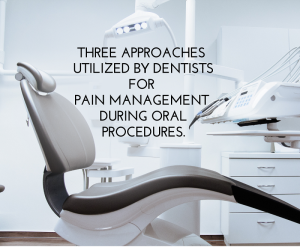 Pain is one of the primary reasons people avoid dental treatment. Many individuals who suffer from chronic dental issues will forgo necessary dental procedures due to a fear of pain. While treatments such as tooth extractions, bridges, and crowns can be uncomfortable, modern dentistry has developed a variety of effective pain management techniques that can make dental procedures much more tolerable. Here are three approaches your dentist may use to manage pain during oral procedures:
Pain is one of the primary reasons people avoid dental treatment. Many individuals who suffer from chronic dental issues will forgo necessary dental procedures due to a fear of pain. While treatments such as tooth extractions, bridges, and crowns can be uncomfortable, modern dentistry has developed a variety of effective pain management techniques that can make dental procedures much more tolerable. Here are three approaches your dentist may use to manage pain during oral procedures:
Sedation Techniques
Sedation therapies help patients relax while the dentist works in their mouths. There are different levels of sedation that dentists can use to manage pain during procedures. The levels of sedation range from minimal, moderate, and deep to general. Minimal sedation is the lightest level of sedation, where the patient is awake and aware but is fully relaxed. Moderate sedation causes the patient to be awake, but their awareness is skewed. Slurred speech and temporary amnesia may occur, but these effects are not harmful. Deep sedation causes the patient to be mostly asleep, but they can be easily brought back to full consciousness with gentle direction. General sedation is rarely used and is mostly reserved for young children or those who cannot cooperate. The dentist will work with you to determine which level of sedation is best for you based on the procedure and your level of anxiety.
Nitrous Oxide Sedation
Nitrous oxide, commonly known as laughing gas, is a form of minimal sedation. The gas is delivered to the patient through a mask that administers an oxygen mixture. When inhaled, the gas causes the brain and body to relax, which makes it easier to tolerate the procedure. Nitrous oxide sedation is one of the most common methods of sedation for oral procedures. Once the gas is started, the effects can be felt within moments. Nitrous oxide sedation is one of the safest methods of controlling pain during oral procedures, and there are almost no side effects after treatment. The amount of medicine delivered is easily adjustable, so if you need more pain relief quickly, the doctor can ease your distress in seconds. Once the gas is working, your dental surgeon will use topical and injectable anesthetics to make your procedure pain-free.
Oral Sedation
Oral sedation is another approach that dentists use to manage pain during oral procedures. It involves taking a combination of medications orally to help manage pain and anxiety. Typically, an anti-anxiety medication is given to the patient, and within 30 to 60 minutes, the patient is relaxed enough to tolerate the procedure. This method works well for those who want minimal to moderate sedation while avoiding needles. Oral sedation is a flexible pain management option that can help make dental visits more comfortable and tolerable.
In conclusion, pain management during oral procedures is possible with the help of your dentist. Don’t let fear of pain keep you from seeking dental treatment. Talk to your dentist at Galan Dental about these pain management options to make your dental visit as comfortable as possible. With the various sedation techniques and methods available, you can get the treatment you need without experiencing unnecessary pain or discomfort.
Remember, maintaining good oral health is essential for your overall well-being, so don’t let fear keep you from seeking treatment.
